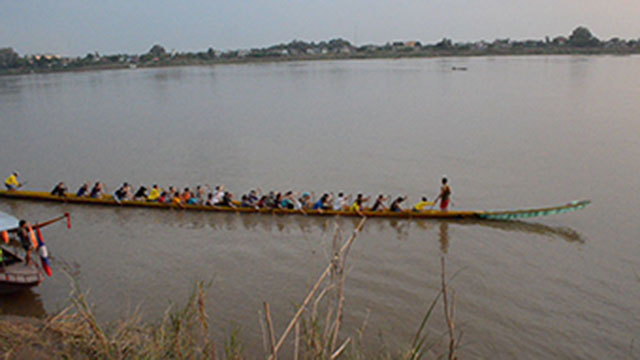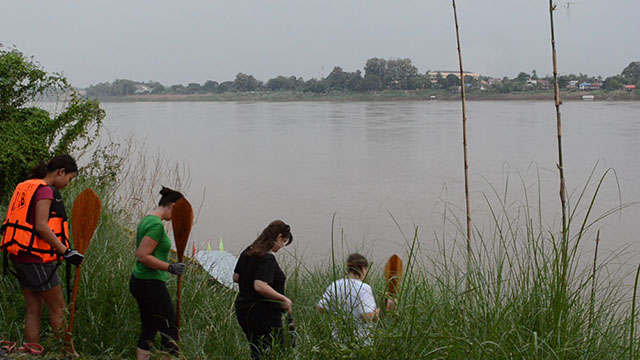VIENTIANE, Laos (MindaNews/19 October)–In Ban Sai Fong Neua, 17 kilometers south from the city center, at least 40 women, each holding a wooden oar, trekked down a steep slope into the Mekong River barely an hour before sunset on Tuesday. Children and husbands of the village women lingered at the cliff and watched a long traditional boat advancing as the river flows slowly.

The Lao-International Women’s Boat Racing Team prepares for its 20th year of joining the race in Vientiane. MindaNews photo by Lorie Ann Cascaro
They composed the Lao-International Women’s Boat Racing Team, a mixture of the village women and falang (expatriate) women from different countries who are living in Vientiane. Even before the race could begin, the team has already “won” this year’s Dragon Boat Racing Festival Women’s Category.
That is simply because the team has remained intact for 20 years now.
Starting today (Saturday) until tomorrow, they will paddle in unison along the Mekong River near the Vientiane Capital not just to compete with the other teams but most importantly to celebrate the sisterhood that they have strengthened for two decades now.
The boat racing has tightened the connection of the international women to the village people through the years.
“We have never won a race but the women continue to participate,” Ruth Foster, an international teacher in her 50s, told MindaNews during the team’s regular practice at the river bank near the village.
Although they trained hard, the women give more value to their friendship and experience, she added.
Foster had been rowing for the team since she arrived in Vientiane almost a decade ago and years later became the coach for English instructions, while a primary school headmaster, Mr Kibou, who has been training the women for 16 years, commands in Lao language.
Lao Women’s Union members, particularly Khamphao Phimasone and Amphone, are key people who have kept the team going through the seasons, Foster said.
The veteran Khamphao recalled the Lao-International Women’s Boat Racing Team first joined in 1993 with already non-villagers and foreigners as members.
While foreign team members were transitory, membership from the village hardly changed year after year. Thus, there is a “surprising amount of continuity” of the group, Foster said.
It is easy to join the team. One can try out and see if she can pursue the training. It is towards the big race day that permanent members get their respective places on the boat.

Women boat racers trek down to the Mekong River to practice for the Dragon Boat Racing Festival women’s category this year. MindaNews photo by Lorie Ann Cascaro
The boat racing festival is held every Boun Ok Phansa, the end of Rains Retreat, which is a three-month fasting of Buddhist monks in the rainy season. It has been a tradition for the Lao-International Women’s Boat Racing Team to bring food and alms to the monks in the morning before going to the race.
“Every year, we went to the temple with our finest, wearing best sinhs with the mandatory scarf over one shoulder and takbat bowls full of offerings for the monks,” Foster said.
But the women fear they could not continue their tradition in this year’s festival.
The competition for women’s category will be held in the morning on the same day that they have to visit the temple. She points out that the race seemed to become “commercialized” in the last two years. The village members find it costly to go the center twice as the boat racing will run for two days with men and women categories being done on separate days.
Nevertheless, the team will surely make it on the race day and paddle at their best.
The tree
Foster recounted their sleepover in a temple at Ban Nakham, about four hours ride from Vientiane in 2009.
There they saw “the tree,” which was eventually turned into their racing boat to replace a 50-year old one.
Boats that are used for the racing festival are made of a single tree. Villagers believe that the spirit of a tree will be transferred to the boat. They pay respects to the spirit by keeping the boat inside the village temple until the next racing festival.
The monks organized the boat making in exchange for the funds that the women raised from sponsorships to build a structure inside the temple compound.
Since they cut a tree, the villagers from Sai Fong Neua and Nakham planted more trees in the area. The relationship between the two villages has grown strongly since the making of the team’s new boat.
Most international paddlers are interns from a range of organizations or individuals working or studying here for a short period, while local members are professionals, employees and market vendors. The race has been a break from their normal day-to-day lives when they can show their extraordinary skills. (Lorie Ann Cascaro of MindaNews is one of the fellows of the FK Norway (Fredskorpset) exchange program in partnership with the Vietnam Forum of Environmental Journalists. She’s currently in Laos and hosted by the Vientiane Times.)
